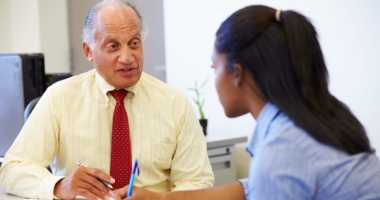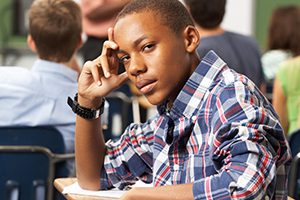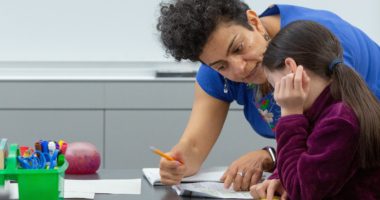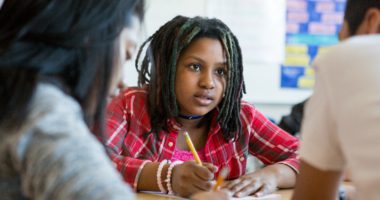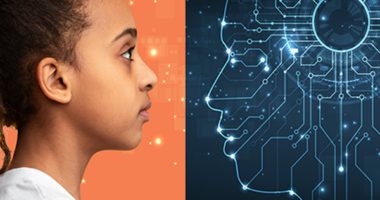LGBTQ Students of Color Speak Up
What does it mean to be young, gifted, and Black — when you’re also queer? This was the question posed to intersectional high school and college students at Duke Ellington School of the Arts in Washington, D.C. The event was hosted by Ed Trust, GLSEN, the National Black Justice Coalition (NBJC) and Education Leaders of Color (EdLoC). But as is typical in the theater, the students took center stage. Here’s what they had to say:
- Chloe, a junior at Duke Ellington who defines as bisexual, explains the difference that an inclusive school climate makes. “During my three years at Duke Ellington, I’ve been surrounded by people who accept me for all the things that I am, even when I’m not accepted at home.”
- Sabira, a senior at Duke Ellington, said that what’s most important is erasing the ignorance toward the LGBTQ community. “People have a bias toward [the LGBTQ community] but they don’t know what it all entails. So we all have to work together to deplete the bias and then inform the community so they feel more connected to it and understand it more.”
- Izayah, a senior theater student at Duke Ellington who came out at 16, said, “Love has a lot to do with the LGBTQ community. All we need is love and acceptance. Straight people want love and acceptance. Well, I’m gay, and — guess what — I want love and acceptance. Just drop the barrier. Because LGBTQ is how I walk, how I talk, how I dress, how I breathe. If I could wave a magic wand, I would hope that everyone would gain love and acceptance.”
- Imani, a sophomore at Howard majoring in political science, said most schools aren’t equipped to handle LGBTQ issues and don’t address the bullying problem earnestly — relying instead on zero-tolerance policies that aren’t effective and that negatively impact students of color. “As a student who went to a White school for high school, I wish that schools were more serious about zero-tolerance bullying policies. They’re all talk and no substance. There’s no way that teachers have stopped bullying in an effective way.”
According to GLSEN’s National School Climate Survey, there has been a recent uptick in school victimization based on sexual orientation, after years of decline (see chart). Eliza Byard, executive director for GLSEN, says there is a sense of urgency given this current climate. “What if you went to school every day to expect violence? Because 4 out of 10 LGBTQ students will be harassed or assaulted at school. That experience of discrimination is real.”

Hostile school climates negatively affect LGBTQ students’ mental health and educational outcomes. “Students experience trauma every single day just by walking out the door. We’re not really treating it as a crisis, but it is,” said Tracie Jade Jenkins, the executive director of The Boris Lawrence Henson Foundation, which was founded by actress Taraji P. Henson to fight the stigma of mental health in the Black community.
There’s also an obligation for state and federal government to create inclusive schools. Ed Trust’s president and CEO John B. King Jr. said, “At the end of the day, the job of government is to make sure that schools are safe and supportive places for all kids where they can thrive. That means that state and federal government have to be intentional about the decisions they make. … Ultimately, we need political will.”
 That’s where activism comes in. Social justice activist Johnetta Elzie says protests are hard, but they must persist if we are to make any headway. “The activism part is so important. You have to do something. Nothing changes if you’re sitting on your butt. Things around here need to be different. The adults need to change, not the kids.”
That’s where activism comes in. Social justice activist Johnetta Elzie says protests are hard, but they must persist if we are to make any headway. “The activism part is so important. You have to do something. Nothing changes if you’re sitting on your butt. Things around here need to be different. The adults need to change, not the kids.”
So what can we do to be strong allies to the LGBTQ community? The four organizations offer three recommendations that advocates, educators, administrators, and school and district leaders can start with to assert students’ identities and provide safe, engaging, and inclusive learning environments for LGBTQ youth of color:
- Develop and teach curricula that is all-encompassing and responsive — representing positive contributions that diverse members of the LGBTQ community have made. Representation matters.
- Provide and ensure LGBTQ students have access to appropriate mental and social supports. Access to school counselors and mental health and socioemotional services are vital to ensure students thrive in and outside of school.
- Affirm the place of organizations that serve LGBTQ people as partners in the fight toward justice for students. These are organizations that have a demonstrated history of effectiveness at increasing cultural competency by providing professional development support to adults in the school setting as well as other caring and concerned adults. Community engagement and connection to schools are critical to student success.


